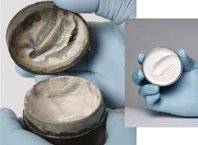
As Richard Evershed and his co-workers wrote in the scientific journal Nature: "Such discoveries from the Roman world are rare. This is the only one to be found so far with its lid and contents, a whitish medicinal or cosmetic cream, providing a unique opportunity to study this ancient formulation."
"This is an extraordinary discovery," commented Federico Nappo, an expert on ancient Roman cosmetics of Pompeii. "It is likely that the cream contains animal fats. We know that the Romans used donkey's milk as a treatment for the skin. However, it should not be very difficult to find out the cream's composition." It was the fashion for Roman women to use special creams to achieve the white appearance that was so fashionable.Moreover the white complexion indicated that the woman could lead a leisured life and not have to toil in the outside with the inevitable consequence of having a tanned skin. To get this necessary white color, the Romans used a combination of fat, starch, and a chemical called tin oxide.Rich Roman women used lead ; not so well off women used flour but they all aimed to have the favoured fair complexion.
 Roman women were no different from their modern counterparts in one respect; they liked dressing up and making the best of themselves.
Wealthy Roman women had slaves who were skilled hairdressers and make-up artists; the less well-off women did their own hair and make-up and used cheaper materials.
The Roman beauty had a white face, red lips, and dark brows and lashes. Her routine consisted, like her modern sister, of cleansing the skin, moisturizing, applying a foundation, and then highlighting the eyes, the cheeks, and the lips.
These creams,as Pliny the Elder remarked in his Natural History were stored carefully:
Roman women were no different from their modern counterparts in one respect; they liked dressing up and making the best of themselves.
Wealthy Roman women had slaves who were skilled hairdressers and make-up artists; the less well-off women did their own hair and make-up and used cheaper materials.
The Roman beauty had a white face, red lips, and dark brows and lashes. Her routine consisted, like her modern sister, of cleansing the skin, moisturizing, applying a foundation, and then highlighting the eyes, the cheeks, and the lips.
These creams,as Pliny the Elder remarked in his Natural History were stored carefully:
"Unguents keep best in boxes of alabaster, and perfumes when mixed with oil, which conduces all the more to their durability the thicker it is, such as the oil of almonds, for instance. " (Pliny the Elder, Natural History, Vol. XIII. Chapter 3)
Plautus, supposedly, wrote, ìA woman without paint is like food without salt" but other writers disapprove of cosmetics in general. One Greek historian from the 4th century wrote about his bride deceiving him prior to the marriage by wearing makeup that didnít show her true looks. Another Greek, Clement of Alexandria, proposed a law that would prevent women from using cosmetics for fear it tricked their husbands into marrying them! Ovid in "Art of Love" wrote of beauty regimes, including depilatory creams of herbs and toners of ground poppy, moistened with water. They sound a far, and much better, cry from the crocodile dung some women used on their faces, according to Dioscorides, a Greek surgeon attached to the Roman army; or the following remedy for preventing wrinkles advocated by Ovid: leaves of maidenhair fern steeped in the urine of a young boy, pounded with saltpeter, then applied to the abdomen.
Sally Pointer with her academic background in archaeology specializes in the use of experimental reconstructions as a way of exploring aspects of life in the past. Basing her knowledge on information gleaned from Roman and Greek writers she demonstrates the use of Roman cosmetics and, "as much attention is paid to the accurate sourcing of ingredients and preparation methods as is paid to the finished look itself." Following the ingredients in the the excavated jar, Sally actually made up a cream. It was very thick,and,whilst fatty in texture, was quickly absorbed by the skin to leave a powdery, mostly matte finish, as a result of the starch.
In her e-mail Sally wrote: "You can actually do a quick and dirty experiment of this yourself if you mix equal parts by weight of lard, or hard vegetable shortening, with cornflour. Its not exactly the same as the original but it`s close enough to give you a clear idea of how it works on the skin. The original had 15% tin but, unless you have a suitable white pigment to hand, just try the base mock-up and see what you think. Fascinating stuff"
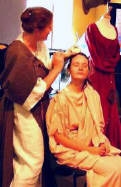
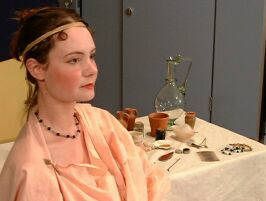
ROMAN MAKEOVER
See also : ROMAN WIGS
Ms. Pointer has very kindly allowed me to use some of her photographs and I do thank her most sincerely.
Maryemm
(How do you get your hair to do that?)
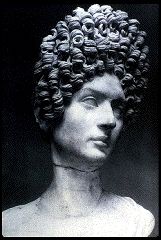
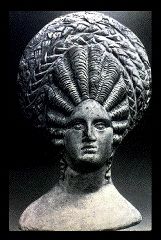 Hairdos were very susceptible to changes in fashion that was dictated from the imperial court. Whereas men in the first and the beginning of the second century wore a short hairdo, women wore hairdos that were much more complicated and that changed with every generation.
Hairdos were very susceptible to changes in fashion that was dictated from the imperial court. Whereas men in the first and the beginning of the second century wore a short hairdo, women wore hairdos that were much more complicated and that changed with every generation.
Women often dyed their hair, usually golden-red. They used false hairpieces to make their hair thicker or longer. Sometimes, Roman women wore their hair up in carefully arranged styles, held with jeweled hairpins. Sometimes they wore it down, curled in ringlets.
Page 18 ~ A MEMORIAL STONE